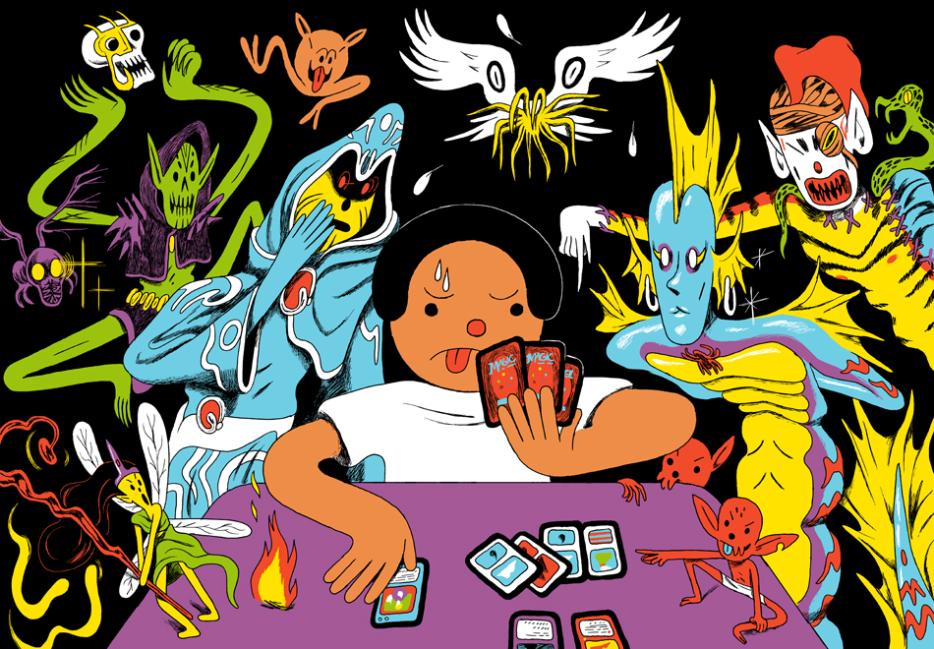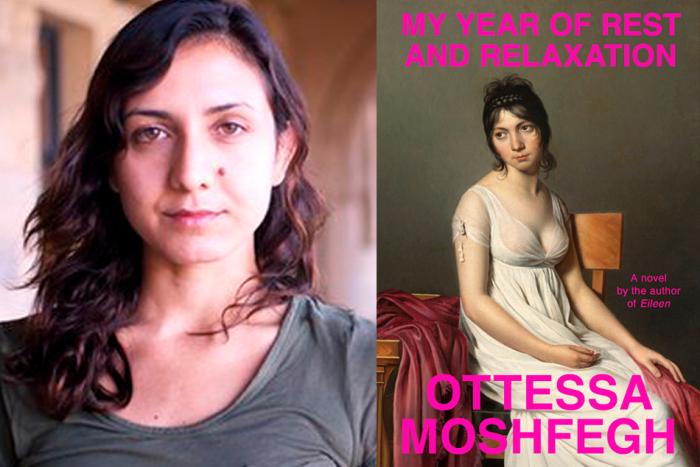Few people spent 1938 feeling very playful. Even while he tried, the Dutch historian Johan Huizinga confessed that such efforts felt futile: “The fun of playing resists all analysis, all logical interpretation.” His book Homo Ludens approached games as an awed pilgrim, describing them in terms of myth and ritual. “There is no distinction between marking out a space for a sacred purpose and marking it out for purposes of sheer play,” Huizinga wrote. “The turf, the tennis-court, the chess-board and pavement-hopscotch cannot formally be distinguished from the temple or the magic circle.” Like holy liturgy, play is “pointless but significant.” Huizinga made his own arrogant distinctions, arguing that “savage” societies conflate mimicry with reality—whereas Europeans would never get so enthralled by ceremony. I doubt his research took him inside the nearest casino.
Fixated on the secrecy and mystery of games, Huizinga missed their role as public spectacles: When his subjects play, there’s never any money at stake. He wanted to map out impossible territory. Chess and roulette are both games, although one involves methodical skill and the other shifts fortunes on a chance bounce. You can play with a piece of chalk or a $2000 computer. None of these definitions are coherent, but they do remain useful. The philosopher Ludwig Wittgenstein used games as an analogy for his theory of language: We move words around following arbitrary rules, their meaning determined by our shared circumstances, trying to express the indescribable. “If a lion could speak,” he said, “we could not understand him.” Imagine teaching that lion how to play poker.
Or picture a creature bent low against the tundra, with flesh striated like dead bark, as if even the trees were starved for prey. From snowdrifts it feeds on a corpse frozen mid-scream. The first Magic: The Gathering card I ever saw also came with a quotation, the last words of one Saffi Eriksdotter, all gothic camp: “Ach! Hans, run! It’s the lhurgoyf!” I didn’t know what a lhurgoyf was, and I certainly couldn’t decipher any of the symbols or rules on that card, but monsters I understood. I lingered over books full of harpies, demons, and basilisks. When other boys teased me for watching Sailor Moon, I would protest, not very convincingly, that the show wasn’t girly at all; it had a whole bestiary of monsters, and those belonged to everybody.
As a kid I used to get myself in trouble for running onto some neighbour’s porch and exploring the terrain. By middle school I had turned into a fat, awkward dork, not bullied but rather ignored, and I resentfully shunned the world back. Magic was a perfect excuse. I spent my allowance money on the lottery of booster packs; I tinkered with decks at the local game shop; I even read the awful tie-in novels, which followed the adventures of a lesser Captain Riker. (I do love Magic’s longest-running villains, the Phyrexians, an empire of techno-organic horrors stitching together the Borg and the Cenobites, with dialogue like: “Father of Machines! Your filigree gaze carves us, and the scars dance upon our grateful flesh.” Someone from the storyline team must realize how horny this sounds.)
There was never any sudden reckoning, as the subjects of a more tangible addiction might describe. The obsession just exhausted itself. Other interests caught my teenage mind, like weird art movies, or sexual confusion, or talking to strangers. For over a decade I barely thought about Magic at all, so that when I started playing again last year it felt both familiar and uncanny, like returning to a house amended by generations of owners.
*
“The question is,” Richard Garfield once asked, “can systems be dramatic? Can math be breathtaking? Can numbers move your soul?” When your work involves things like “the distribution of the binomial coefficients modulo p” (his PhD thesis), these are cosmic problems, but Garfield figured out how to make aesthetics from mathematics. He comes from an unusual family; one great-great-grandfather was James Garfield, the president only remembered for getting himself shot by a deranged office-seeker (before gruesomely lingering two more months as America’s finest surgeons prodded the wound). Another relative invented the folding milk carton. Garfield’s own father was an architect whose job took them across the world, and his lonely son noticed how people would play board games together when they had nothing else in common.
The Seattle games publisher Peter Adkison later recalled their first encounter in 1991: “Then as now, [Garfield] wore mismatched socks, had strange bits of thread and fabric hanging from parts of his clothing and generally looked like someone who had just walked into the Salvation Army and grabbed whatever seemed colourful.” Still a doctoral student at the University of Pennsylvania, Garfield approached him with the idea for a board game called RoboRally, but Adkison’s new company Wizards of the Coast had only published traditional RPGs—he feared they didn’t have the resources, and asked to see a simpler concept. Garfield realized that you could use trading cards to expand and complicate a universal set of rules. Back in Pennsylvania he began to mock up prototypes, enlisting friends or strangers as playtesters. Garfield wanted every match of Magic to feel like a different experience; he thought that people would only buy one or two starter decks each year, discovering unseen cards on the other side of the table. When you read about how those earliest players spent half the time trading pieces of scrap paper, it sounds a little naïve.
The cards themselves were more sophisticated: Magic’s rules have hardly changed in twenty-five years. Simplified here and there, rephrased, but fundamentally consistent. You still start every game with twenty life and a sixty-card library, pulling out an opening hand of seven. Each turn you draw one fresh card and get to play a single land, “tapping” them for mana to cast your spells. If you run out of life, typically from creatures attacking it, you lose. Instead of nation or species, Garfield arranged Magic’s factions into five colours, a far more abstract and elegant design. White preaches order, community, and sometimes cruel orthodoxy. Blue pursues knowledge as if that can solve everything (a blue mage would definitely respond to personal essays with “citation??”). Green’s nature sprites might dance you through flowers or trample you underneath elephants. Red passion rouses, liberates, scorches. Black admires ambition, but not scruples. Wittgenstein once wrote that “I treat colour concepts like the concepts of sensations,” and Garfield knew how evocative that palette could be.
When Magic first went on sale in 1993, the comic book speculator market was starting to collapse, a correction that eventually drove Marvel Comics into bankruptcy and most of North America’s specialty shops out of business. The remaining stores depended on trading cards and gaming, and Magic somehow offered both. Titus Chalk’s recent book Generation Decks records how quickly it spread: “A month or two on from release, [Wizards of the Coast] had grown from five employees to twenty-two. By May 1994, that number had swelled to over fifty. With a recruitment policy dubbed the 'nearest warm body' hiring approach, the company ranks were filling with anyone Wizards could get their hands on.” In Seattle, a city of zine collectors with rock bands, the recruiting favoured vaguely countercultural nerds. Years later, one employee described the atmosphere back then: “Wizards was a big horny summer camp.”
Capitalism endures yet remembers nothing, so the comic book bubble only made way for a glut of new card games. There were collectible card games (CCGs) devoted to familiar genre franchises, like Star Wars and Star Trek, along with more baffling entries; for a moment in the mid-’90s, you could play games adapting The X-Files or Austin Powers. Nearly all of them went dormant long ago, leaving Magic as the survivor. Its generic setting turned out to be an advantage—you can’t lose the license or run out of storylines for fantasy worlds you’ve just made up. Not that anyone at Wizards entirely knew what they were doing: Richard Garfield developed Arabian Nights, Magic’s first expansion set, without playtesting a single match. Right before going to print, somebody noticed they’d forgotten to add flavour text, and the head editor wrote it all in a sleepless trance: “Expect my visit when the darkness comes. The night I think is best for hiding all.” At least Scheherazade had an audience.
Other early expansions were assigned seemingly at random: Wizards art director Jesper Myfors handled The Dark, designing outwards from its aesthetic of sinister preachers and backwoods rituals. Legends got made by some Garfield friends in Vancouver, who created cards inspired by their Dungeons & Dragons characters. Sales doubled with every set anyway, and Wizards began to worry about hoarding. They printed 1994’s latest expansion Fallen Empires in the ever-growing numbers retailers demanded—350 million cards, more than twice as many as every previous set combined. You can still find sealed product lying around undisturbed at gaming stores today, like canopic jars in some Egyptian tomb. The pitifully low power level didn’t help, and for a time it seemed that Magic might be another collectible fad: POGs with dragons.
Few players understood the game yet either; the earliest tournaments often devolved into giant monsters smashing against each other. Eventually people figured out that, although a Craw Wurm cost six mana to cast, you could kill or counter it for a fraction of those resources. A group of Bay Area players started testing increasingly defensive decks, focused on drawing extra cards, forcing them out of the opponent’s hand, and dealing with multiple threats at once. Before long they just called it “The Deck.” That definite article was not immodest; they had hit on crucial aspects of Magic, which pulled competitive play between the stations of a trinity. Control decks attack like a python, using card advantage to slowly exhaust all resistance. Aggro decks try to force through lethal damage with maximum efficiency. Combo decks win the game in a single ridiculous move, e.g. taking infinite turns, creating an unstoppable 20/20 creature, or generating huge amounts of mana. These extremes often blur together—the Delver of Secrets archetype resembles aggro-control, backing up a cheap threat with lots of ways to kill/disrupt things—which only makes them easier to obsess over.
By 1996 the scene had matured enough that Wizards of the Coast decided to sponsor a circuit of professional events, which still influences tournaments down to the local shop. Magic pros earn a living closer to lacrosse players than NBA stars, although rotating the main format’s deckbuilding pool every year or two does sell plenty of booster packs. All of that was alien to me. I only remember staring at the cards themselves, and it doesn’t feel like mere nostalgia to say they’ve never looked better. Richard Garfield had always discouraged the busty-valkyrie style of fantasy art, but Sue Ann Harkey, Magic’s art director back then, came from outside the gaming world entirely; for the expansions Mirage and Visions, inspired by various African cultures, she recruited gallery painters and comics artists. There are many Magic cards showing some kind of enormous demon, but Mirage’s Spirit of the Night unnerves me most—it seems to melt forward from abstraction, a trick of the landscape.
Harkey hired illustrators who became some of the game’s most celebrated: Rebecca Guay, whose watercolors bring to mind stained glass; Kev Walker, a graduate from the chunky-grotesques school of British cartooning; Terese Nielsen, with her sense of serene grace. She also found artists who got swiftly dispatched after Harkey left, my favourite being the voluptuously sexual figures of Robert Bliss. In his paintings, it is always big boy season. “Rob, being the naughty chap that he is, would put penises in everything,” Harkey later told the Magic blogger Jesse Mason. “And ever since [a particularly well-disguised one on the card Polymorph], everyone looked for penises… and then I couldn’t commission him any more.” There’s Magic art I love from recent years—Guay’s Bitterblossom must be one of the most beautiful things ever printed on a piece of cardboard—but the reigning style is bland competence, like illustrations marketing some lavishly expensive video game, almost flaunting their conservatism.
*
In 2012, Richard Garfield published a book called Characteristics of Games, describing his medium with the structural analysis that Roland Barthes brought to narrative. To play is to wander an “impossible idea,” he wrote: “A game must keep hope alive for a reversal of fortune, even while reassuring players that everything they do has a place in a fixed progression.” Characteristics of Games can be surprisingly funny, albeit with a mathematician’s sense of humour—during one aside Garfield notes that “taste is not commonly a factor in games, except perhaps in sports if things go drastically wrong”—and it sometimes sounds existential about that tension between human caprice and grand designs. “Aesthetic appeal and support of gameplay can work against each other,” Garfield argues. “Aesthetic considerations often push for a greater ornateness, and gameplay wants simplicity of interface … Thus in some sense artists and game designers are natural enemies.”
Garfield created Magic: The Gathering, but he left Wizards of the Coast two decades ago after Hasbro bought the company. The game’s dominant figure over all those years has been Mark Rosewater, a former screenwriter, not a professor; he likes to joke about his old Roseanne credits. Rosewater prefers the language of genre tropes to mathematic systems. He has written that his goal is to entertain players while meeting their expectations, not unlike a Hollywood producer running some cinematic universe. Rosewater’s official title is head designer, but he also serves as Magic’s media face, marketing pitchman, and court historian. Imagine if chess were owned by a single company, and the same person creating new boards chronicled the game’s past while telling everyone how great chess was. And because that company promised not to reproduce many older, powerful chess pieces out of deference to collectors, certain formats only really get played online, the one place where enough people can afford it.11Mt. Gox, the bankrupt bitcoin exchange, began life as a Magic trading post. Until his own downfall, it was rumored that Martin Shrekli tried to buy out various out-of-print cards. Magic is both performance and commodity, a pas de deux maneuvering around display cases.
Perhaps Rosewater had that contradiction in mind when he called the widest upheaval of his tenure “New World Order,” although his ambitions fell short of a planet ruled by liberal capitalism. The idea was to simplify more common cards, especially for booster draft (where you take picks one by one, like a sports draft, and then build your miniature deck). Much as I love looking at complicated Magic boards, those don’t always reveal good design—players might have to study a dozen overlapping effects, few of them immediately meaningful. Several of the most popular draft formats were developed following New World Order guidelines, including the consensus favourite, 2011’s horror-inspired Innistrad. So many cards from that set feel deceptively complex, serving different roles depending on your plan; one deck used a bunch of thirteenth picks to dump its entire library into the graveyard zone, food for an army of spiders. To evoke transformations at dusk, Rosewater created double-sided cards, which can shift from human to monster. No other theme has shaped his designs so neatly.
Dominaria, the latest Magic set, returned to the game’s home plane for the first time since 2006, with Garfield making guest contributions. It’s the most open-ended expansion in years, even after they restrained his stranger ideas—like the Sagas, a new card type meant to represent living mythology. Yet the designs still feel safer than Future Sight, our previous visit to Dominaria. That set used nostalgia as an excuse to combine dozens of mechanics, some long gone and others only envisioned, with startling effect. One card does nothing outside of the graveyard. Another can counter your opponent’s spell for free, or rather in advance; if you don’t pay its mana cost on your next turn, you lose the game. Future Sight approached history like a revisionist, fracturing accepted notions of how Magic should play. Dominaria presents a timeline of ancient relics and legendary heroes, expecting their due reverence.
The New World Order era coincided with Magic’s audience growing exponentially, an imperial phase now tailing off. Around the middle of the last century, French sociologist Roger Caillois critiqued Johan Huizinga’s idealized definition of play in Homo Ludens: “It is true that the kinds of games are almost infinitely varied, but the constant relationship between chance and profit is very striking … In certain of its manifestations, play is designed to be lucrative or ruinous.” Caillois never imagined how deep that relationship might run, arguing that, although a casino mogul extracts money from each gambler (“the entrepreneur alone does not play”), play itself creates no wealth or material goods. He could not foresee the esports industry, which generates hundreds of millions of dollars from people watching other people play video games. Magic puts up similar numbers in paper form, but it lags behind its younger digital cousins online. Hearthstone usually ranks among the top five games of any genre by streaming viewership; Magic scrapes to #30 on a good month.
In The Characteristics of Games, Richard Garfield mentions an early example of play turning self-conscious, from Edo-period Japan: “The annual go games played before the shogun were eventually played out entirely in advance, the players sequestered to prevent knowledge of the results from leaking out, and then the games replayed for the shogun, all to prevent them from lasting too long for the spectators.” How simple can you make a game with 15,000 unique cards? Magic Online remains ugly to watch partly because it needs to handle every possible interaction—and many famous decks hinge on exploiting those intricacies. People like to say they’re playing “as Garfield intended,” the joke being that the designer always wanted his creation to mutate out of control. Garfield once wrote that his own favourite Magic card is Shahrazad, from the Arabian Nights expansion, which starts a new game within the game.22Asked about his favourite writers in a 1990s interview, Garfield mentioned Borges and Calvino. It’s also one of the very few spells to get banned in every competitive format, since clever mages can cast it over and over until time loses all meaning.
Coveting the esports market, Wizards has developed a flashier program called Magic: The Gathering Arena, limited to recent sets; given the design mistakes defying Rosewaterist orthodoxy, with more cards banned over the past year than the previous decade, that pitch may not be so enticing. I haunt Magic Online in spite of its looks. When I first returned to the game, I’d spent a month homeless, crashing on couches. My days were featureless blanks contorted by anxiety. Every inscrutable aspect of Magic fascinated me: I loved how improvised booster draft feels, as alliances form and dissolve. It balances chess’s chilly purity with the social theatre of poker. When I mentioned this piece to my friend Michael DeForge, a cartoonist and part-time mage, he wrote back: “I like that Magic is always a puzzle. The deck building is a puzzle, your draft choices are a puzzle, and each game is a puzzle. Even deciding what hands to keep.”33DeForge provided the illustration for this story.
At the height of World War II, the mathematician John von Neumann framed economics as a conflict between rational individuals, establishing the field of game theory. That would prove less convincing than his models for the first nuclear bomb. Von Neumann once argued that chess is not a game at all, because one player can always theoretically force a tie (mutual assured destruction). The precise series of moves involved remains a mystery, too vast for our computers to calculate, not that that offers weaker players any hope. In The Characteristics of Games, Garfield estimates the odds that a chess amateur will prevail against a grandmaster—they’re also the chances of winning the New York lottery seven times straight. But Magic’s rules allow for randomness, the harlequin behind every card. Novices sometimes bring down hall-of-famers. Nineteenth-century gamblers would seek guidance from dream books, which fastened surreal images to each play, like a soothsayer. They shared as we do an ancient fantasy, to sense the Fates losing grasp of your thread.






